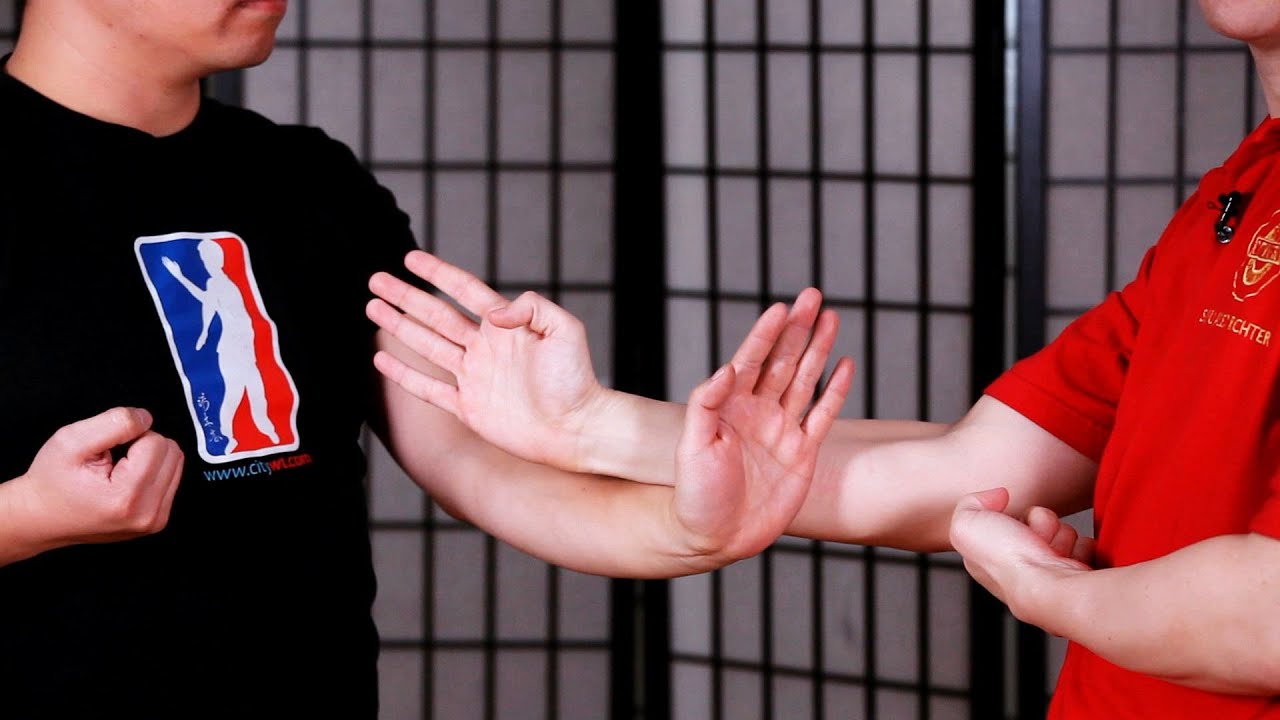Dan Chi Sau aka Single Hand Chi Sau | Wing Chun
Full Playlist: https://www.youtube.com/playlist?list=PLLALQuK1NDrjD8mIyjOcPsGaJBDQN-6-K
–
–
Watch more How to Do Wing Chun videos: http://www.howcast.com/videos/509893-Dan-Chi-Sau-aka-Single-Hand-Chi-Sau-Wing-Chun
When the students start to learn chi sao, they start, instead of with two arms, we start with one arm. This is what we call single-arm chi sao, or dan chi sao. And it’s a very simple standard format that we start with and this is just a progression. Once the student learns single-arm chi sao, they can then progress to double-arm chi sao.
So, we start in a very traditional way. We start using the frontal stance and one partner’s going to be in the outside position using fok sau. The other partner is going to be in the inside position using tan sao. Now, what I wanna do, okay, before he learns to defend, is I want to attack him with a palm strike right here. This is in fact the palm strike that we have from the Siu Nim Tau form, okay? It’s very important when you do the palm strike in single-arm chi sao not to do the palm strike down. Some instructors teach their students to do the palm strike here. This is a little bit problematic. First of all, if I gave him a full-power palm strike right there to the stomach with my wrist like this, I’ll probably end up hurting myself. In the form, this palm strike is actually done horizontally, it’s not done low. So this is suited for the palm, or of course, in application, for the face.
So, when you practice the palm strike, you wanna make sure that it goes towards your partner’s chest. If I have forward pressure and he gives me a low palm strike, I would just go forward and hit him. There’s no need for me to chase this arm down here like that. So, when he gives me a palm strike, I’m going to use jam sao to defend, okay? And jam sao is just a slight sinking of the elbow and I occupy the center line here. What you don’t wanna do is you don’t wanna do anything like jat sao or pull back like this. And sometimes instructors teach our students this. This can be a little dangerous, because you’re basically drawing your partner to come in and give you a hit. So when he gives me a palm strike, I’m going to use the jam sao to occupy this line. Now from here, I close my fist, keep my elbow low, and I’m gonna give him a punch, which is going to turn his arm up into bong sao, based on the theory press the head, and then the tail raises here like this.
So the standard dan chi exercise looks like this: palm strike, which is reacted to by jam sao, and then punch, he does bong sao like this. Now, if you notice, my elbow is low, my fist is in front of his chest, it’s not in front of his face. And the reason is because if I give him a palm strike and he does jam, and he punches me towards my face, I’m going to go forward and wedge him this way here. There’s no reason for me to do a bong sao against a face punch because this will just become a ramp for him to hit me in the head. So, I will only do bong sao when he gives me a low elbow punch this way here. When he gives me a high punch towards the face, he’s gonna get this one here. There’s no need to do bong sao against a high punch. And this is the basic dan chi exercise.



![[ID: P_s1ZXG_4VA] Youtube Automatic](https://okumasaati.net/wp-content/uploads/2020/10/id-ps1zxg4va-youtube-automatic-360x203.jpg)
![[ID: aE5-2kqnDOk] Youtube Automatic](https://okumasaati.net/wp-content/uploads/2020/10/id-ae5-2kqndok-youtube-automatic-360x203.jpg)
![[ID: oweOJsgVPec] Youtube Automatic](https://okumasaati.net/wp-content/uploads/2020/10/id-oweojsgvpec-youtube-automatic-360x203.jpg)
![Private: [ID: Bw0iTOPn2X8] Youtube Automatic](https://okumasaati.net/wp-content/uploads/2020/10/private-id-bw0itopn2x8-youtube-a-360x203.jpg)
![[ID: cQzNm7BQQ7U] Youtube Automatic](https://okumasaati.net/wp-content/uploads/2020/10/id-cqznm7bqq7u-youtube-automatic-360x203.jpg)
![[ID: po5M32gi9sw] Youtube Automatic](https://okumasaati.net/wp-content/uploads/2020/10/id-po5m32gi9sw-youtube-automatic-360x203.jpg)